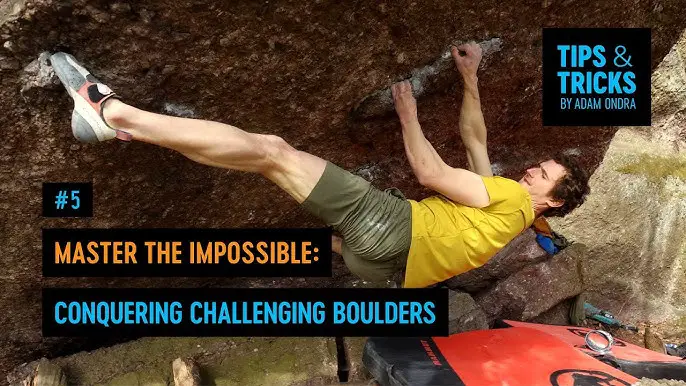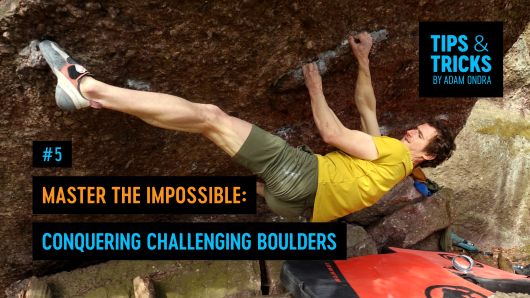For rock climbing beginners, focus on proper gear, learning techniques, and building strength gradually. Implementing these tips will enhance your climbing skills and make your experience safer and more enjoyable.
Rock climbing is a physically demanding and mentally stimulating activity that requires careful preparation and practice. By following these beginner tips, you can develop essential skills, improve your climbing technique, and progress to more advanced climbs. With the right approach and mindset, rock climbing can be a rewarding and thrilling way to connect with nature and challenge yourself.
Whether you are climbing indoors or outdoors, these beginner tips will set you on the path to becoming a confident and capable rock climber.


Credit: www.adamondra.com
Essential Gear
For beginner rock climbers, essential gear includes a harness, rope, carabiners, and climbing shoes. These tools are necessary for safety and successful ascents. Invest in quality gear to ensure a comfortable and secure climbing experience.
Essential Gear for Rock Climbing Climbing Shoes Climbing shoes are crucial for rock climbing to provide grip and support. Ensure shoes fit snugly to avoid slipping and ensure stability while climbing. Look for shoes with sticky rubber soles for better traction on different surfaces. Consider getting specialized climbing shoes designed for the type of climbing you’ll be doing. Harness and Belay Device Harness is essential to safely attach yourself to the rope while climbing. Choose a harness that fits comfortably around the waist and legs for security. Belay device is a critical piece of equipment for controlling the rope and providing safety. Ensure proper training on how to use the belay device correctly before climbing. Remember to double-check all gear before climbing for safety and security.Technique And Form
Developing proper technique and form is crucial for beginner rock climbers. Mastering foot placement and utilizing handholds effectively are key components to ensuring a successful climb.
Foot Placement
- Position your feet securely on footholds for stability.
- Place your weight on the balls of your feet, not your heels.
Using Handholds Effectively
- Grip handholds firmly but avoid over-gripping to conserve energy.
- Utilize a combination of pinch holds, crimps, and slopers to navigate routes.
Safety Measures
When it comes to rock climbing, safety should always be your top priority. As a beginner, it’s crucial to understand and implement proper safety measures to ensure a secure and enjoyable climbing experience. In this section, we will cover essential safety tips regarding proper knot tying and understanding climbing signals.
Proper Knot Tying
One of the most fundamental aspects of rock climbing safety is mastering the art of proper knot tying. Before you embark on any climbing route, learning how to tie secure knots is essential. The figure-eight knot is widely used in climbing due to its reliability and strength. It’s important to practice tying and checking this knot repeatedly until it becomes second nature.
Understanding Climbing Signals
Effective communication is key to ensuring a safe climbing experience. Understanding climbing signals and commands is crucial for effectively communicating with your belayer and fellow climbers. Familiarize yourself with standard signals such as “safe,” “tension,” and “take,” to ensure clear and concise communication while on the wall.
Training And Conditioning
When it comes to rock climbing, training and conditioning play a crucial role in ensuring your success on the wall. Building strength, flexibility, and endurance is essential for beginners who are venturing into this exciting sport. In this section, we will explore various exercises and techniques that can help you improve your climbing abilities.
Strength And Flexibility Exercises
To conquer the challenges of rock climbing, it is important to focus on building strength and improving flexibility. By incorporating specific exercises into your training routine, you can enhance your overall performance and reduce the risk of injuries. Here are some essential exercises for beginners:
- Finger Strength Training: Climbing heavily relies on finger strength, so it is crucial to train your fingers to withstand the demands of the sport. Utilize fingerboards or hangboards to perform exercises like dead hangs and pull-ups to strengthen your grip.
- Core Strengthening: A strong core is vital for maintaining balance and stability while climbing. Include planks, Russian twists, and leg raises in your workout routine to target your core muscles.
- Upper Body Exercises: With rock climbing primarily utilizing the upper body, it is essential to strengthen your arms, shoulders, and back. Incorporate exercises such as push-ups, pull-ups, and shoulder presses to develop upper body strength.
- Flexibility Training: Flexibility is key to performing dynamic movements and reaching difficult holds. Include stretching exercises like shoulder rolls, wrist stretches, and hip openers to improve your flexibility.
Endurance Building
In addition to strength and flexibility, endurance plays a vital role in rock climbing. Building your endurance allows you to sustain energy throughout a climb, enabling you to tackle longer and more challenging routes. Here are some effective techniques to enhance your endurance:
- Interval Training: Incorporate intervals of moderate to high-intensity climbing into your sessions. Alternate between periods of intense climbing and rest to push your endurance limits.
- Aerobic Exercises: Engage in cardiovascular exercises such as running, cycling, or swimming to improve your overall endurance levels.
- Route Progression: Gradually increase the difficulty of your climbs to push your endurance boundaries. Start with easier routes and gradually work your way up to more challenging ones.
- Breathing Techniques: Proper breathing techniques allow you to conserve energy and maintain focus during climbs. Practice diaphragmatic breathing and learn to regulate your breath to improve your endurance.
By incorporating these strength and flexibility exercises, as well as endurance-building techniques into your training routine, you can progress as a rock climber and tackle increasingly challenging routes. Remember, consistency is key, so make sure to establish a regular training schedule to see improvements in your climbing abilities.
Outdoor Climbing Tips
Outdoor climbing is an exhilarating experience, but it can also be a bit intimidating for beginners. To help you make the most out of your outdoor climbing adventures, we have compiled some valuable tips that will enhance your skills and boost your confidence. Whether you are a newbie or have some indoor climbing experience, these tips will give you the edge you need to excel in outdoor climbing.
Reading Routes
Reading routes is a crucial skill that every outdoor climber needs to master. It involves analyzing the terrain and identifying the best path to reach the top. Here are some tips to help you become a pro at reading routes:
- Take your time to study the route before you start climbing. Observe the holds, cracks, and any potential challenges or variations.
- Look for natural features that can guide you, such as prominent cracks, ledges, or distinctive rock formations.
- Pay attention to the color or texture changes in the rock as they often indicate different climbing difficulties or routes.
- Identify potential resting spots or areas where you can place protection gear.
Dealing With Height And Exposure
Height and exposure can be intimidating for beginners, but with the right mindset and techniques, you can conquer your fears. Here are some tips to help you deal with height and exposure:
- Take deep breaths and focus on your breathing to calm your nerves. Remember, fear is natural, but you have the ability to overcome it.
- Start with routes that are within your comfort zone and gradually progress to more challenging ones.
- Use visualization techniques to picture yourself successfully completing the climb. Visualization can help you build confidence and reduce anxiety.
- Trust your gear and the safety measures in place. Always double-check your harness, ropes, and anchor systems before starting your climb.
- Communicate with your climbing partner or belayer and let them know how you’re feeling. They can offer reassurance and support.

Credit: www.amazon.com

Credit: www.youtube.com
Frequently Asked Questions For Rock Climbing Tips For Beginners All The Tricks And Hacks
What Are The Essential Rock Climbing Gear For Beginners?
To get started with rock climbing, you’ll need some key gear like climbing shoes, a harness, a helmet, carabiners, and a belay device. These essential items will provide you with the necessary safety and support while climbing.
How Can Beginners Improve Their Rock Climbing Technique?
Beginners can improve their rock climbing technique by focusing on building strength, practicing proper foot placement, mastering handholds, and developing core stability. Taking climbing classes or working with an experienced climber can also help refine their skills and climbing techniques.
What Are Some Safety Tips For Beginners In Rock Climbing?
For beginners in rock climbing, safety should be a top priority. Always check your gear before climbing, use proper belay techniques, communicate clearly with your climbing partner, and learn how to fall safely. It’s also important to know your limits and not push yourself beyond what you are comfortable with.
Is Rock Climbing Suitable For All Ages And Fitness Levels?
Rock climbing can be enjoyed by people of all ages and fitness levels. It offers a variety of routes and difficulty levels, so individuals can progress at their own pace. However, it is important to consult with a medical professional before beginning any new physical activity, especially if you have pre-existing health conditions.
Conclusion
In closing, incorporating these rock climbing tips for beginners into your routine can greatly enhance your climbing experience. By practicing proper techniques, staying safe, and being mindful of your physical and mental limits, you’ll be well on your way to becoming a proficient climber.
Keep pushing yourself and enjoy the adventure!